Special Report
25 Counties With the Widest Income Gaps

Published:
Last Updated:

The gap between the rich and poor has continued to widen in the United States. While the wealthiest 5% of U.S. households earn at least $203,000 annually, the bottom 20% earn less than $22,000 a year. The difference is far wider than even five years ago.
Income inequality has been on the rise in almost every part of the United States for well over three decades. While some income inequality should be expected, rising inequality has serious consequences. Extreme income disparities hinder upward social mobility, increase racial segregation, and fuel gaps in health and wellness between the rich and poor.
Income inequality is far more pronounced in certain parts of the country. 24/7 Wall St. reviewed U.S. Census Bureau data to identify the 25 counties with the widest income gaps. The counties on this list span a number of regions — from the Northeast to the Midwest — and can be either urban areas or largely rural counties.
Plenty of cases of income inequality are found in large, wealthy, urban areas, where the luxury of the rich and the deprivation of the poor are often visible. Many of the most extreme cases of income inequality, however, are in poor, rural areas.
Click here to see the 25 counties with the widest income gaps.
Click here to see our detailed findings and methodology.
These are the 25 counties with the widest income gaps.

25. Holmes County, Mississippi
> Population: 18,772
> Households earnings $200,000 or more: 0.2%
> Households earnings less than $10,000: 27.8%
> Median household income: $20,732
Workers in lower-paid, lower-skilled jobs often also have little job security and can find themselves unemployed more often. As a result, areas where a large share of the workforce is employed in such positions tend to have higher income inequality. Holmes County is located in the Mississippi Delta, a region that has struggled with high unemployment for decades as the ongoing mechanization of agriculture led to job losses in the area’s main industry. An estimated 9% of Holmes County’s labor force is unemployed, twice the 4.5% national unemployment rate. Nearly 28% of area households earn less than $10,000 a year — the largest share in the nation. Still, despite the area’s harsh economic conditions, a small percentage of households manages to earn at least $200,000 annually.
[in-text-ad]

24. Clarke County, Georgia
> Population: 120,905
> Households earnings $200,000 or more: 2.8%
> Households earnings less than $10,000: 19.5%
> Median household income: $32,162
Like several of the most unequal counties, Clarke County is home to a major university, the University of Georgia. College towns tend to have high income inequality on paper as many off-campus college students have little to no income. While these individuals can skew some income metrics, the university further contributes to real income inequality as it employs some of the area’s highest income residents. While professors and administrators at the university can earn six-figure salaries or higher, other workers have access primarily to low-paying service jobs. Nearly 37% of Clarke County’s population lives in poverty, more than twice the national poverty rate of 15.5%. More than 55% of all income in Clarke County is earned by the top quintile of households, among the largest such shares nationwide.

23. Richmond, Virginia
> Population: 213,735
> Households earnings $200,000 or more: 4.4%
> Households earnings less than $10,000: 13.1%
> Median household income: $40,758
Richmond is one of 38 cities in Virginia treated by the Census as equivalent to counties. The city is the largest in Virginia and has the highest income inequality in the state. About 57% of all income in Richmond is earned by the richest 20% of households, one of the largest shares nationwide. Like other unequal areas across the country, educational attainment and incomes are sharply divided along racial lines in Richmond. While 61% of white adults have a college degree, just 14% of black area adults have completed college, one of the largest such discrepancies in the country. As is generally the case across the U.S., these measures are divided along geographic lines as well. While the median household income in some neighborhoods to the east of Interstates 64 and 95 is less than $12,000, the typical household in wealthier neighborhoods such as Wilton and Windsor Farms in the northwest corner of the city earns more than $200,000.

22. Chicot County, Arkansas
> Population: 11,353
> Households earnings $200,000 or more: 1.8%
> Households earnings less than $10,000: 17.9%
> Median household income: $28,913
Income inequality in Chicot is the highest of any county in Arkansas and among the worst of any county nationwide. Higher numbers of jobless workers will contribute to income inequality. In tough labor markets, employers are also less likely to offer high wages to attract the best workers. An estimated 7.1% of Chicot County’s labor force is unemployed, one of the higher unemployment rates in the country.
The wealthiest town in Chicot County is the county seat Lake Village, where the median household income is $30,486 a year, well below the national median. The richest 5% of households in Chicot County earn 29% of the total area income, one of the largest such shares of any county.
[in-text-ad-2]
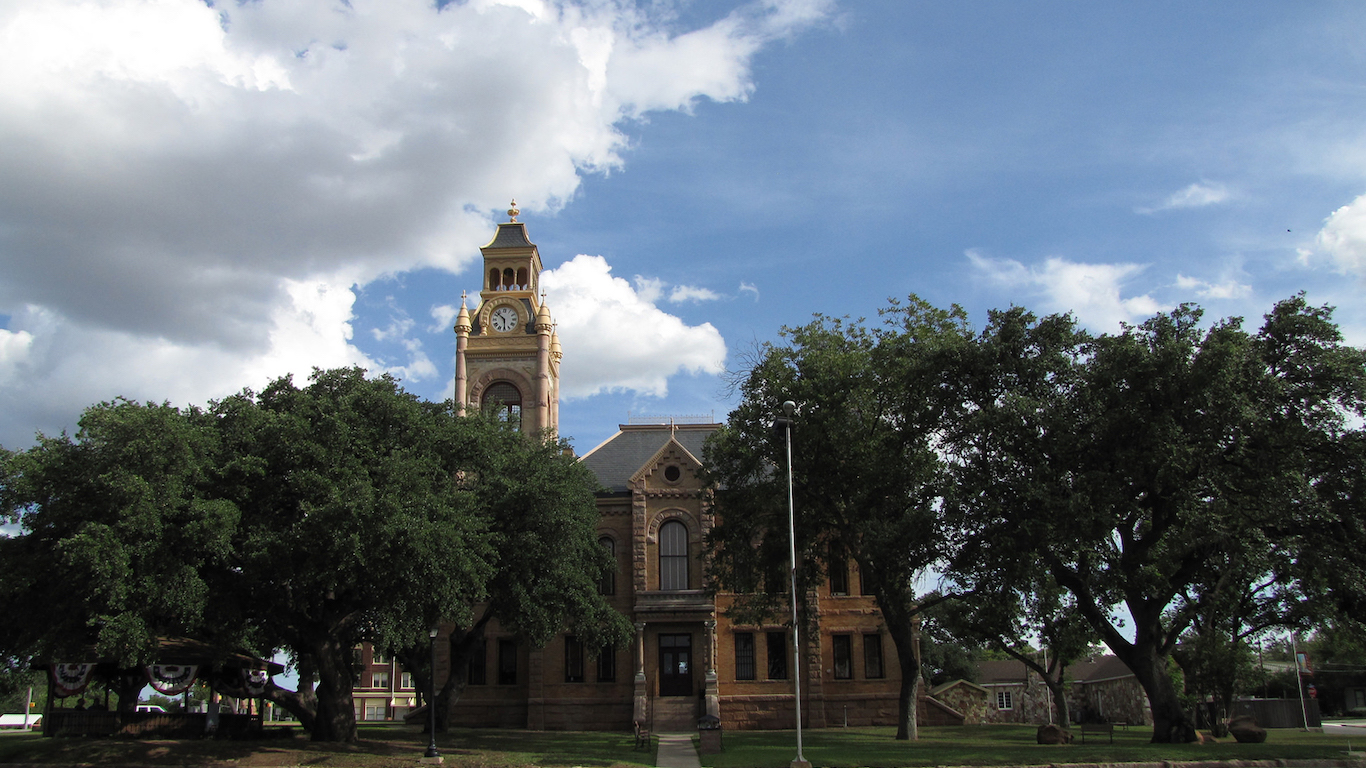
21. Llano County, Texas
> Population: 19,323
> Households earnings $200,000 or more: 6.5%
> Households earnings less than $10,000: 6.8%
> Median household income: $48,259
Llano is one of seven Texas counties among the 25 U.S. counties with the worst income inequality. As is the case with many areas on this list, the income gap in Llano corresponds with educational attainment gaps. Further, in Llano County the typical high school graduate earns just $23,000, versus the median earnings for U.S. adults with a high school diploma of $28,000. Meanwhile, the median annual earnings for adults with a bachelor’s degree in Llano County is roughly $48,000, about the same as it is nationwide.
Compounding the income gap caused by education, it seems that workers without a high school diploma in Llano County are also far more likely to live in poverty than people with similar educational attainment nationwide. About 33% Llano County residents who have not finished high school live in poverty, compared to 28% of similarly educated individuals nationwide.

20. Campbell County, South Dakota
> Population: 1,548
> Households earnings $200,000 or more: 4.5%
> Households earnings less than $10,000: 6.3%
> Median household income: $45,170
Like the nation as a whole, incomes have risen substantially in Campbell County in recent years. While the median household income has risen roughly $2,300 since 2010, incomes did not increase evenly throughout the county population. Income inequality in Campbell County has worsened at nearly the fastest rate of any county nationwide. In 2010, income in Campbell was relatively well distributed. Today, the top 5% richest households in the county earn nearly a third of all income, well above the 22.8% share of all income earned by the richest 5% nationwide.
[in-text-ad]

19. Greene County, Georgia
> Population: 16,331
> Households earnings $200,000 or more: 5.4%
> Households earnings less than $10,000: 13.3%
> Median household income: $42,408
Greene County is home to a number of establishments that clearly target wealthy visitors and residents seeking luxury activities. Reynolds Lake Oconee, a residential community boasting lakefront real estate, four marinas, 117 holes of golf, and properties selling anywhere from $300,000 to $900,000 is within county limits. The Reynolds community is also the largest employer in the county, providing nearly 1,100 county residents with jobs — albeit low-paying, primarily service level occupations.
The highest quintile of households in Greene County earn 57.7% of all income, above the comparable national share of 51.2%. At the same time, the lowest quintile earns less than 2.3%, even lower than the national share of 3.1%.

18. Fairfield County, Connecticut
> Population: 939,983
> Households earnings $200,000 or more: 18.1%
> Households earnings less than $10,000: 5.1%
> Median household income: $84,233
With a median annual income of $84,233, among the highest of all counties nationwide, Fairfield County, Connecticut residents are some of the wealthiest people in the country. About 18% of area households earn $200,000 or more annually, one of the highest such share nationwide. However, these figures mask the stark gaps between the rich and poor in the area. The county contains Bridgeport, an all but abandoned industrial town where the median household income is $42,000. Fairfield also contains Darien, home to gated communities, hedge fund managers and billionaires, and where the median household income is $209,000.

17. San Augustine County, Texas
> Population: 8,695
> Households earnings $200,000 or more: 1.6%
> Households earnings less than $10,000: 18.3%
> Median household income: $28,275
Over recent decades, agriculture and timber corporations have overtaken what used to be small operations and family farms in San Augustine. As a result, while some higher-paying jobs were created within the companies, the change mostly resulted in lower-paying farm jobs. This created an income imbalance and likely deepened income inequality.
Today, with high unemployment in the area — 9.2% versus the 4.5% national rate — the top 5% of households in the county earn 30% of the income, one of the largest shares nationwide.
[in-text-ad-2]

16. Divide County, North Dakota
> Population: 2,314
> Households earnings $200,000 or more: 8.1%
> Households earnings less than $10,000: 4.4%
> Median household income: $56,042
Aptly named Divide County has some of the highest income inequality of any U.S. county. The top 20% of households in the county earn over $120,000 a year. Meanwhile, the bottom 20% earn a maximum of $22,300 a year. Farming is the county’s largest industry, and in recent years, area farmers have suffered financially. Total earnings among farmers have fallen 71.5% since 2010 even as employment in the industry fell by just 6.4% over the same time period.
North Dakota’s tax code takes measures to reduce financial burdens for low income population. Homeowners earning less than $42,000 a year are eligible for property tax credits. Those earning less than $22,000 are effectively exempt from paying property tax. These policies are likely especially beneficial to low income residents of Divide County.

15. Fulton County, Georgia
> Population: 983,903
> Households earnings $200,000 or more: 10.5%
> Households earnings less than $10,000: 9.0%
> Median household income: $57,207
The county seat of Fulton is Atlanta, which itself is one of the most unequal cities nationwide. Atlanta is in the northern part of the county, which contains some of the wealthiest cities in Georgia. In cities such as Milton and Johns Creek, the median annual household income is above $100,000. In South Fulton, however, the situation is slightly different. In cities such as College Park and Union City, the typical household earns less than $35,000 annually.
The typical college graduate in Fulton County earns 2.2 times the typical high school graduate who did not complete a four-year college program, one of the highest premiums on a bachelor’s degree in the country.
[in-text-ad]

14. Essex County, New Jersey
> Population: 791,609
> Households earnings $200,000 or more: 9.6%
> Households earnings less than $10,000: 9.3%
> Median household income: $53,976
Much of Essex County is located less than 30 miles from Manhattan, and many county residents likely commute to high-paying jobs in and around New York City. The county contains some of the wealthiest towns in the state, including Essex Fells, Upper Montclair, and North Caldwell, where the median household income is exceptionally high, at over $200,000 a year. The county also contains some of the poorest towns — like Newark, where the typical household earns only $33,139 a year. Across the county as a whole, 20% of households take home less than $20,000 annually. Meanwhile the highest earning 20% earn over $127,000 a year.

13. Lowndes County, Alabama
> Population: 10,742
> Households earnings $200,000 or more: 1.5%
> Households earnings less than $10,000: 17.3%
> Median household income: $25,876
Lowndes is one of the poorest counties nationwide, and even its wealthiest residents do not have especially high incomes. In cities such as Hayneville, Gordonville, Mosses, and White Hall, the median household income is less than $20,000 a year. The wealthiest city in the county is the historic Town of Lowndesboro, where the typical household earns roughly $40,000 a year. Lowndes County lacks any advanced, high-paying industries, and its economy is still largely agricultural. Major employers in the area include Bates Turkey Farm and Priester’s Pecans, which likely offer relatively low-wage positions. One in five Lowndes County households earn less than $11,000 a year, and the top 5% of households earn more than $130,000 a year.
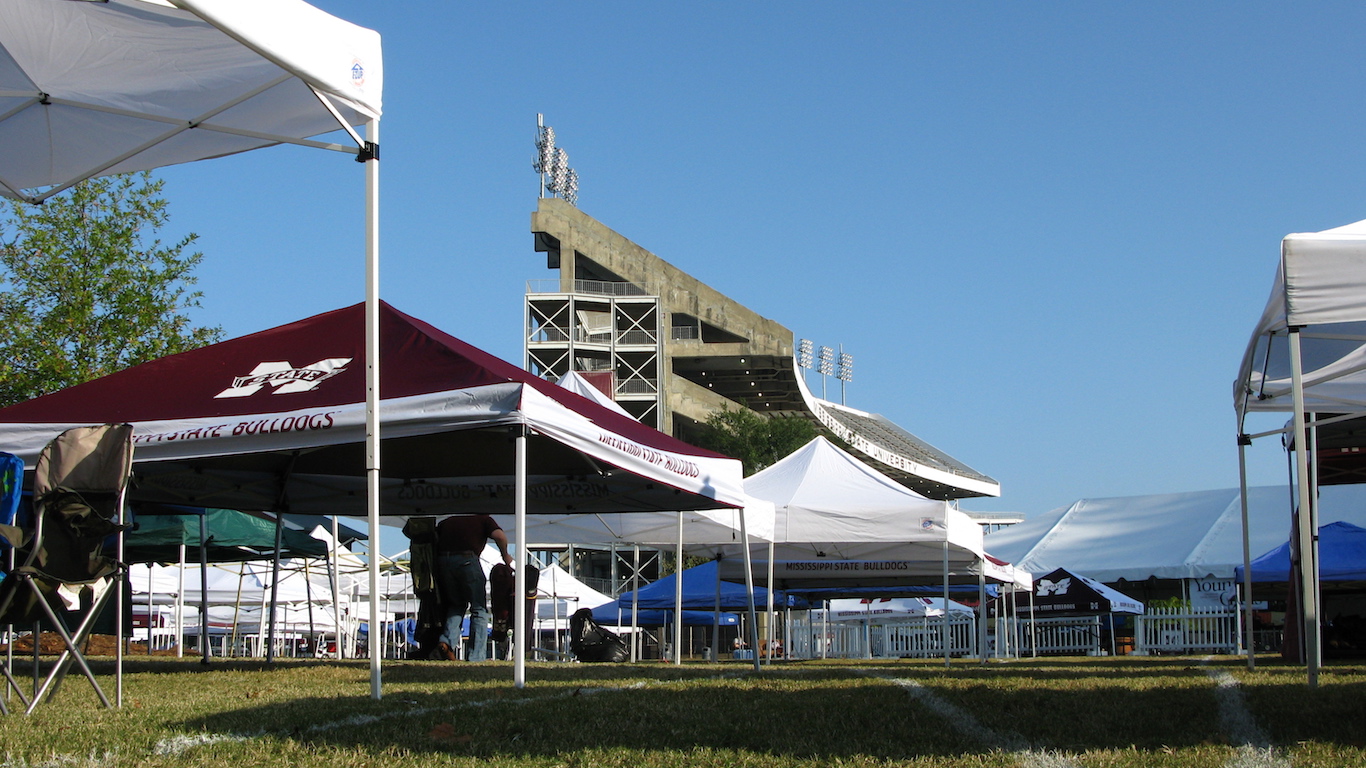
12. Oktibbeha County, Mississippi
> Population: 49,048
> Households earnings $200,000 or more: 2.5%
> Households earnings less than $10,000: 19.0%
> Median household income: $32,485
With a median annual household income of $32,485 Oktibbeha County is one of the poorest counties in the United States. Still, the county is not without its high earners. Approximately 5% of households earn over $164,000 a year.
Oktibbeha County is home to Mississippi State University, and many county adults are employed by the school. One of several college towns on this list, higher educational institutions pay a relatively small number of professors high salaries and a relatively large number of support staff far lower wages. At Mississippi State, the average professor annual salary is nearly $99,000. Meanwhile, the average annual salary among instructors, the lowest ranking faculty members, is only $44,800. The average salary among the school’s staff is likely far lower.
[in-text-ad-2]

11. Natchitoches Parish, Louisiana
> Population: 39,330
> Households earnings $200,000 or more: 2.1%
> Households earnings less than $10,000: 19.3%
> Median household income: $31,345
Natchitoches Parish is one of the poorest counties nationwide. Nearly than 30% of the population lives in poverty, almost twice the corresponding national figure. While Natchitoches Parish has some of the highest income inequality in the country — more than one in four dollars earned in the county goes to the top 5% of households — few parish residents are actually among the top earning Americans nationwide. Just 2.1% of households earn at least $200,000 annually, less than half the national figure.

10. Pitkin County, Colorado
> Population: 17,420
> Households earnings $200,000 or more: 10.4%
> Households earnings less than $10,000: 4.5%
> Median household income: $71,196
Situated in the Rocky Mountains, west of Colorado Springs, Pitkin County is home to resort towns Snowmass Village and Aspen. Both areas are relatively wealthy, with median annual incomes of $81,000 and $67,200, respectively. With some of the most popular ski mountains in North America, Pitkin County is a popular place for those who can afford it. It is one of only eight counties on this list where the richest 5% of households earn more than a quarter million a year. Partly because the area attracts so much money, Snowmass Village offers employee housing for service workers in the area, who are likely among the region’s lowest earning individuals. Many of the resort’s employees may be among the 20% of households earning less than $33,000 a year in Pitkin County.
[in-text-ad]

9. Eastland County, Texas
> Population: 18,328
> Households earnings $200,000 or more: 2.5%
> Households earnings less than $10,000: 12.2%
> Median household income: $34,888
The Eastland County population spiked during an oil boom in the 1920s and has since been on a steady decline. The agriculture industry grew as oil production tapered off, and today Eastland is one of many agricultural economies characterized by uneven income distribution and high poverty. In recent decades, mechanization of farming practices and the takeover of family farms by large corporations has turned many farm workers into low-wage employees and has widened disparities in income. Roughly one in every three dollars of income in Eastland County is earned by just 5% of households, one of the highest such proportions in the nation.

8. Orleans Parish, Louisiana
> Population: 376,738
> Households earnings $200,000 or more: 4.9%
> Households earnings less than $10,000: 16.1%
> Median household income: $36,792
The Orleans Parish comprises the city of New Orleans, which has one of the largest income disparities in the nation. While the typical household in neighborhoods such as Uptown, Carrollton, and Algiers earns more than $150,000 a year, there are neighborhoods in Mid-City where the median household income is less than $10,000 a year. Income inequality in New Orleans was exacerbated by Hurricane Katrina, which caused roughly $75 billion in damage when it hit the city in August 2005. The city’s population, housing stock, and business establishments have yet to return to their pre-Katrina levels, and the recovery has been slowest for the area’s poor population. According to figures from the Urban League of Greater New Orleans, the income gap between white and black residents in the city has increased more than 37% since 2005.

7. Borden County, Texas
> Population: 705
> Households earnings $200,000 or more: 8.8%
> Households earnings less than $10,000: 1.9%
> Median household income: $73,750
With only about 700 residents, Borden has one of the smallest populations of any county in Texas. Wealthier than the nation as a whole, Borden County, Texas has a high concentration of wealth among a small share of residents. The richest 5% of households in the county earn over a quarter million a year, versus the 5% of households nationwide who earn more than $203,000. Additionally, the lowest quintile of earners in Borden County earn less than $30,500 a year, versus the lowest quintile of households nationwide who earn less than $22,000. So despite the wide income gap, residents are on the whole relatively well off financially. Only 1.1% of area residents rely on SNAP benefits compared to 13.2% of U.S. residents.
[in-text-ad-2]

6. Baylor County, Texas
> Population: 3,628
> Households earnings $200,000 or more: 5.3%
> Households earnings less than $10,000: 12.8%
> Median household income: $36,373
Like many areas on this list, the median income in Baylor County of $36,373 is one of the lowest in the nation. One in every five households in the county earn less than $15,000 annually, and about 40% of households earn less than $31,000 a year. The 5.3% of households who earn at least $200,000 annually is low compared with the nation, but one of the highest shares compared with other low income areas.
Like several other counties on this list, Baylor’s economy seems to be in decline. The population of Seymour, the county seat, has declined from a high of 3,700 in the mid 1980s to about 2,500 today.
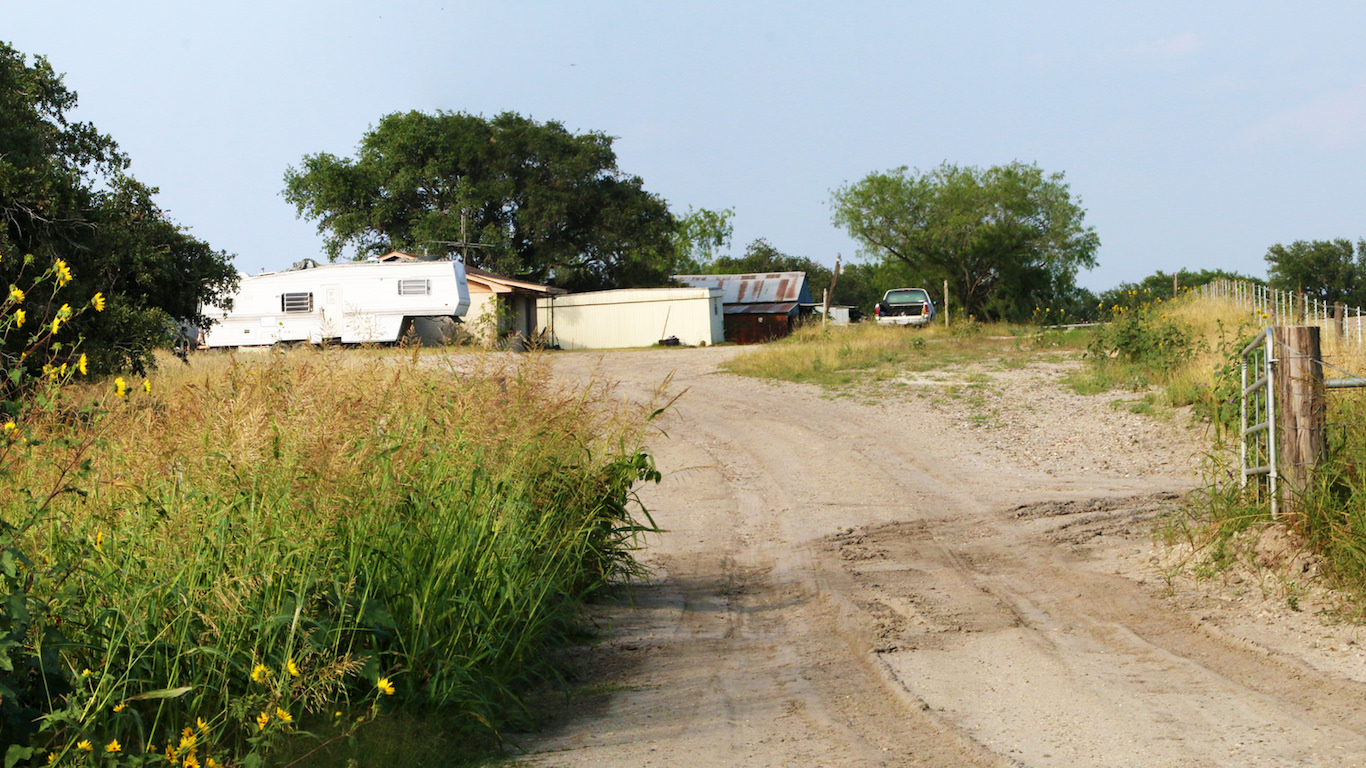
5. Karnes County, Texas
> Population: 14,879
> Households earnings $200,000 or more: 7.1%
> Households earnings less than $10,000: 10.8%
> Median household income: $45,502
Karnes County has the fifth largest income disparity of any county nationwide. While one in five households earn less than $15,200 a year, the wealthiest 5% of households earn at least $250,000 a year. Areas with large energy sectors tend to also have higher income inequality. Large uranium deposits in the region have helped make Karnes one of the largest producers of the valuable mineral in the nation. The area economy has also profited from oil and gas extraction for decades. Close to 20% of the county’s workforce is employed in natural resource extraction, versus 9% of the U.S. workforce employed in such occupations.
As uranium mining companies have expanded their operations in South Texas over the past several years, income disparity has further increased. Income inequality in Karnes County has increased more than 10 times as fast as it did nationwide since 2010.
[in-text-ad]
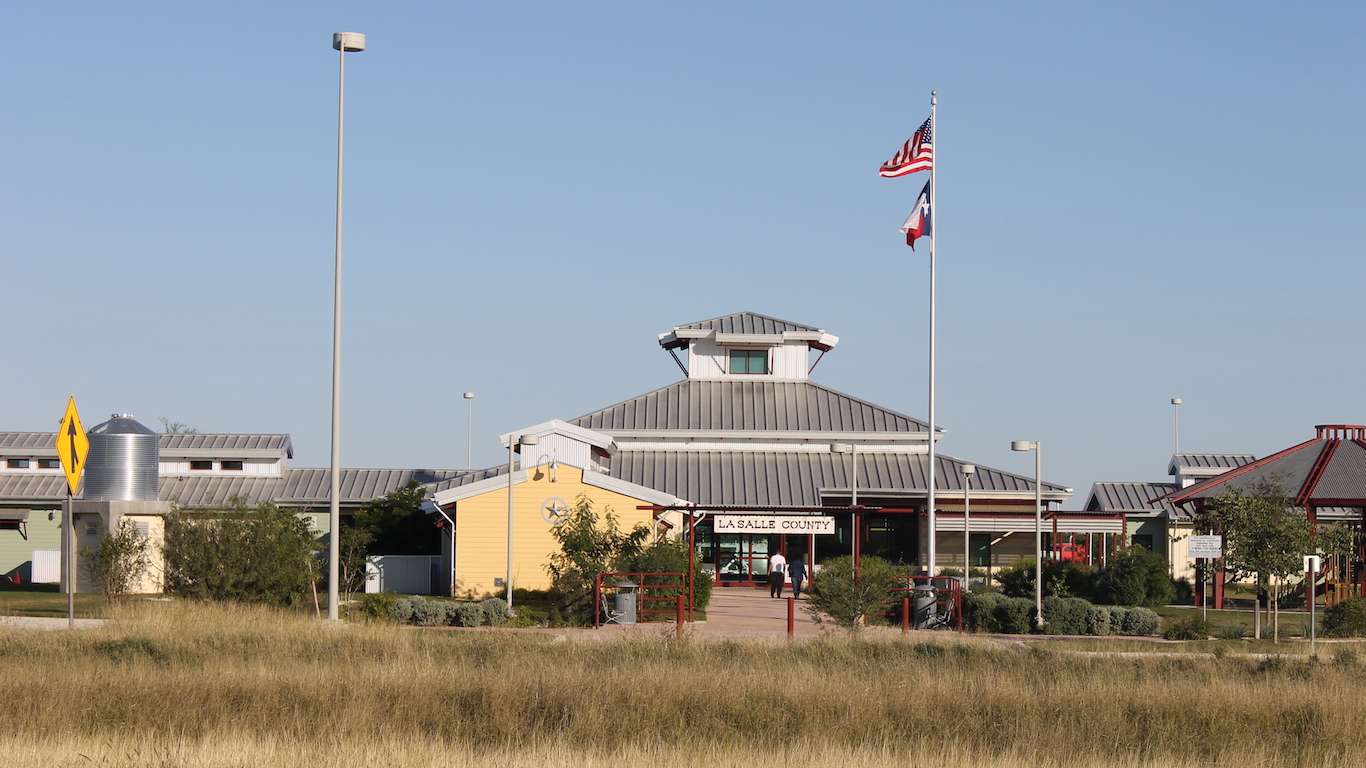
4. La Salle County, Texas
> Population: 7,191
> Households earnings $200,000 or more: 5.3%
> Households earnings less than $10,000: 10.4%
> Median household income: $37,292
La Salle County is located in southern Texas, about halfway between San Antonio and the Mexico border. Across the county, 20% of households earn 66% of all income, the highest share of any county in the United States. The highest earning 5% of households earn at least $216,000 annually. On the other end of the income spectrum, one in five households in La Salle County earn less $16,000 a year. Income inequality in the area is far worse today than it was just five years ago. While income inequality nationwide has gotten more extreme in the last half decade, it has worsened at more than 10 times the national pace in La Salle County.
Research has shown that the immense value of energy resources, which owners can profit from while workers cannot, can drive income disparities in area economies dependent on such industries. After Karnes County, La Salle is the second largest crude oil producing county in Texas. Close to 25% of the county’s workforce is employed in the sector.

3. New York County, New York
> Population: 1,629,507
> Households earnings $200,000 or more: 18.3%
> Households earnings less than $10,000: 9.5%
> Median household income: $72,871
New York County, which comprises the borough of Manhattan, has the third widest income gap of any U.S. county. While the typical household in neighborhoods adjacent to Central Park earns more than $230,000 a year, and in Tribeca more than $250,000 a year, the typical household in neighborhoods such as East Harlem and the Lower East Side earns below $17,000 a year.
Income in Manhattan is largely split along racial lines, and the inequality can be partially explained by racial disparities in educational attainment. While 82.5% of white adults in Manhattan have a bachelor’s degree, the same can be said for only 29.0% of black adults and 23.7% of Hispanic adults. College graduates earn 2.8 times as much as high school graduates in Manhattan, the fifth highest education premium nationwide.

2. Calhoun County, Georgia
> Population: 6,489
> Households earnings $200,000 or more: 3.2%
> Households earnings less than $10,000: 18.8%
> Median household income: $25,513
The Calhoun County economy is largely agricultural, and more than 50% of county land is designated as prime farmland. In recent years, however, the number of family farms has declined as large corporations have bought up farmland. As ownership of these farms has shifted from families to large corporations, income inequality has increased. The income gap in Calhoun County has widened at more than 10 times the national pace since 2010, and today the county has the second largest income disparity nationwide. Nearly two in every five dollars earned in the area goes to just 5% of households.
While farming activity has increased in Calhoun County in recent years, the shift from family farms to corporate operations has lowered area wealth overall. As the share of households earning $200,000 or more doubled from 1.4% in 2010 to 3.2% today, the median household income fell from $30,522 to $25,513 — one of the lowest of any U.S. county.
[in-text-ad-2]
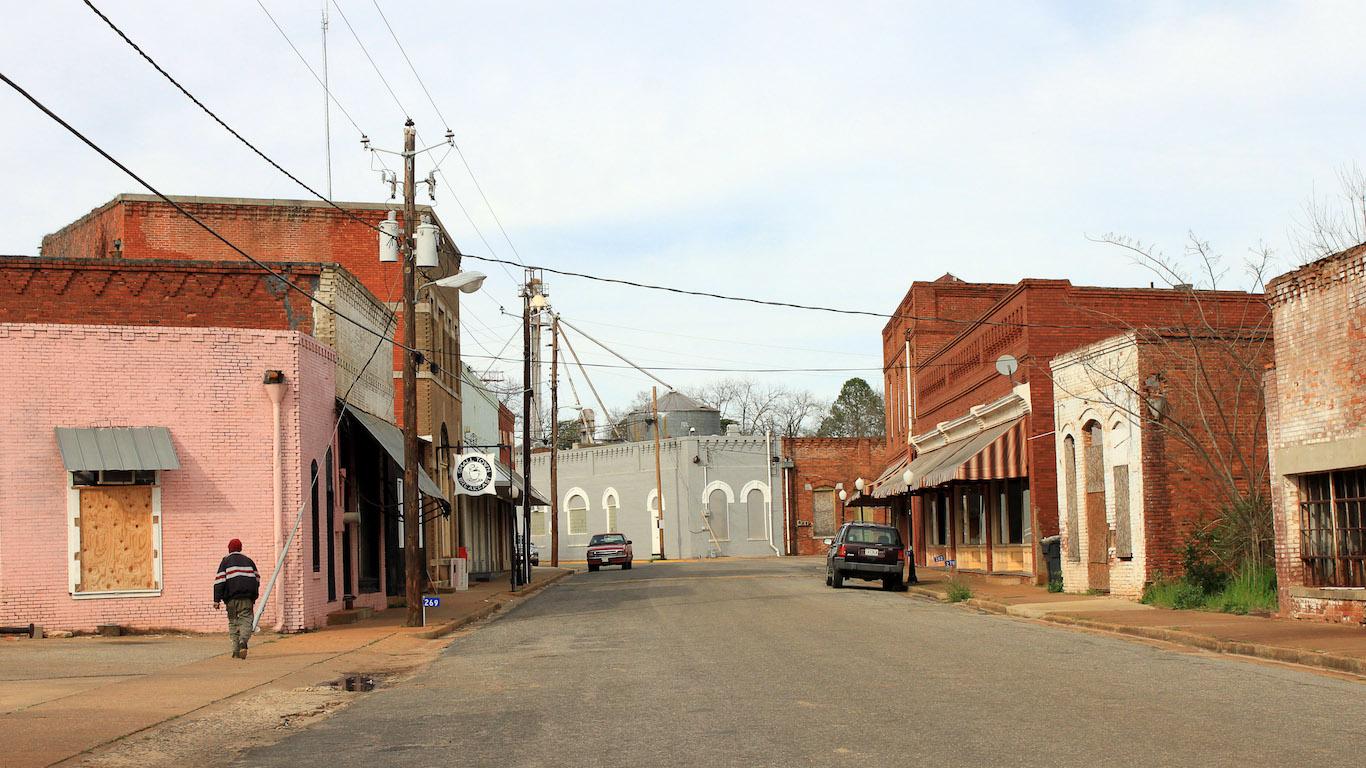
1. Randolph County, Georgia
> Population: 7,315
> Households earnings $200,000 or more: 2.1%
> Households earnings less than $10,000: 15.9%
> Median household income: $28,377
No county in the United States has greater income inequality than Randolph, Georgia. An extremely poor county, more than one in every four residents depend on government assistance in the form of SNAP benefits. Additionally, the highest earning 20% of county households earn at least $59,000 a year. In comparison, the highest earning 20% of households nationwide make about $109,000 or more annually. The countywide median annual household income is only $28,377 — and in two towns in the county, Cuthbert and Shellman, the typical household earns less than $24,000 a year. The area’s economic picture is underscored by a worsening job market. In the last five years, the number of jobs in the county has declined by 14%. Over the same period, income inequality in Randolph County increased at roughly five times the national pace.
While by no means the nation’s wealthiest, 5% of Randolph County’s households earn at least $133,000 annually.
Detailed Findings and Methodology:
Because incomes can go up infinitely but can only go so low, many may assume the worst income inequality is in the nation’s wealthiest areas, but this is not necessarily the case. Overall, incomes often decline as income inequality persists — especially in the nation’s poorest areas.
Notably, in Calhoun County, Georgia — the county with the second widest income gap — while the share of households earning $200,000 or more doubled from 1.4% in 2010 to 3.2% today, the median annual household income fell from $30,522 to $25,513 — one of the lowest of any U.S. county.
In other counties are on this list, an outsized share of the population is extremely wealthy. Nationwide, only about 5% of households earn $200,000 or more a year. In four of the counties with the widest income gaps, more than 10% of households earn over $200,000. Including these four areas, the top 5% of earners in eight counties on this list earn over a quarter million dollars annually.
In many rural economies, which are heavily represented on this list, income inequality is exacerbated by industries that provide large incomes for a small group of wealthy land and business owners and low salaries to the majority of laborers. In recent years, large agricultural corporations have increasingly displaced family farms in rural areas.
Similarly, research has shown that the immense value of energy resources, which owners can profit from while workers cannot, can drive income disparities in economies that depend on such industries.
The presence of a large university in a county — especially if the university is the largest and highest paying employer in the area — can also explain the area’s wide income gap. In counties such as Oktibbeha County, home to Mississippi State University, professors earn six-figure salaries, while a much larger number of university staff work in low-paying service jobs. Additionally, the measure of income inequality may be skewed by the large number of college students living off-campus who earn little to no income.
To determine the counties with the widest income gaps, 24/7 Wall St. reviewed the Gini coefficient — a measure that denotes income inequality — for 3,142 counties in the United States. Data came from the U.S. Census Bureau’s American Community Survey and are five-year averages for the period between 2011 and 2015. Supplementary data on population, poverty, occupation, median household income, the share of households earning less than $10,000 a year, the share of households earning $200,000 or more a year, the share of households receiving food stamps/SNAP benefits, and household earnings by quintile also came from the Census Bureau and are five-year averages of the period between 2011 and 2015. Unemployment rates came from the Bureau of Labor Statistics and are seasonally adjusted estimates for March 2017.
The thought of burdening your family with a financial disaster is most Americans’ nightmare. However, recent studies show that over 100 million Americans still don’t have proper life insurance in the event they pass away.
Life insurance can bring peace of mind – ensuring your loved ones are safeguarded against unforeseen expenses and debts. With premiums often lower than expected and a variety of plans tailored to different life stages and health conditions, securing a policy is more accessible than ever.
A quick, no-obligation quote can provide valuable insight into what’s available and what might best suit your family’s needs. Life insurance is a simple step you can take today to help secure peace of mind for your loved ones tomorrow.
Click here to learn how to get a quote in just a few minutes.
Thank you for reading! Have some feedback for us?
Contact the 24/7 Wall St. editorial team.